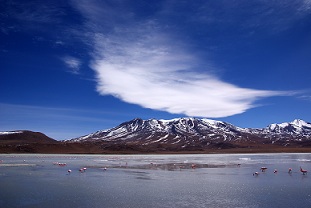Secrets of an ‘extreme’ Andean bacteria

Related topics
Funding Researchers Marie Skłodowska Curie actions Germany Climate action, environment, resource efficiency and raw materialsVirginia Albarracín, a 34-year-old biologist from Argentina, is on an adventure which has taken her from fieldwork in the high-altitude lakes of the Andes to the western corner of Germany in pursuit of the secrets hidden in tiny, yet robust bacteria. Their ability to survive extremes in temperature and ultraviolet (UV) light, as well as inhospitable conditions makes them what Dr Albarracín calls a “model species for study”.
In 2010, together with a team of scientists at the National Scientific and Technical Research Council (CONICET) in Tucumán, Argentina, she helped to identify the protein that makes the hardy Acinetobacter so extraordinarily resistant to these harsh extremes and (it turns out) capable of repairing its own damaged DNA – genes containing instructions for the development and functioning of most living organisms.
These discoveries could one day lead to future biotech applications ranging from highly protective sun-screen lotions – based on compounds that filter UV light – to new treatments for tumours and even insight into future energy solutions.
“But we mustn’t forget this is basic research,” Dr Albarracín points out, “which means there is no commercial application envisaged in the short term, but there is always a lot of promise when something so out of this world is discovered.”
Micro-cosmos … what a super bacteria reveals about the secrets of life
The researchers found millions of “super bacteria” thriving inside oxygen-starved lagoons of north-western Argentina. The bacteria’s habitat, which includes high arsenic and salinity levels, is similar to primitive Earth before living and breathing organisms began wrapping a protective atmosphere of oxygen around the planet.
Previous discoveries by the CONICET team, led by microbiologist Dr María Eugenia Farías, include living stromatolites and rare microbial mats – dubbed the oldest and “most extreme microbes known on Earth”. An overnight sensation, these tough life forms were featured in Nature, BBC and El Mundo, and the news of their discovery led to the lagoons where they live being proposed as a UNESCO World Heritage Site.
The bacterial strains collected in Argentina have been sent for analysis at the Max Plank Institute (MPI) for Energy Chemical Conversion in Mülheim, Germany – a world-renowned centre for photochemistry and biophysics.
Dr Albarracín, with help from a Marie Curie Fellowship, chose to follow the bacteria to Germany where, under the EU-funded Screening and functional analyses of photoreceptors in extremophilic microbial communities (Extremophil) project, she continues to study the genetic material allowing these organisms to thrive in such diverse conditions. Results of this work, under the renowned chemist Professor Wolfgang Gärtner, have already appeared in the journal Origins of Life and Evolution of Biospheres (Springer).
The rarefied conditions of the high Andes are proving to be a “high window” through which scientists can understand the past (primitive life on Earth) but map out the future (new applications).
“The extreme conditions that we found these organisms in are an excellent analogue of Mars,” she explains, which makes Acinetobacter and its habitat a model system for the study of life on other planets, and has previously attracted the likes of NASA to the region.
There is also talk of a whole new branch of ‘turquoise’ biotech products one day coming out of research into these hardy organisms. “This symbolises the colour of the Andean lakes where they live,” says Dr Albarracín.
